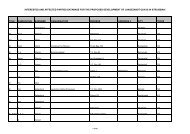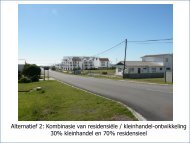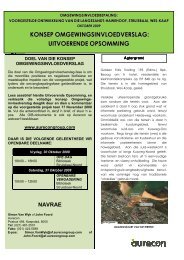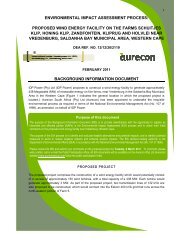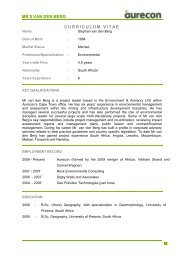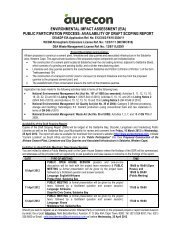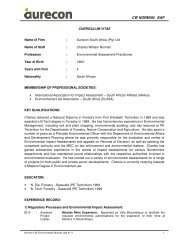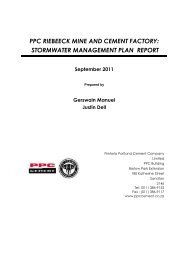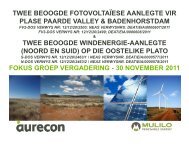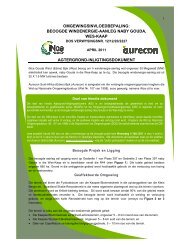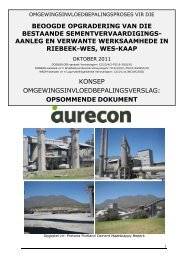Final EIAR - Aurecon AME Environmental | Environmental Projects
Final EIAR - Aurecon AME Environmental | Environmental Projects
Final EIAR - Aurecon AME Environmental | Environmental Projects
You also want an ePaper? Increase the reach of your titles
YUMPU automatically turns print PDFs into web optimized ePapers that Google loves.
Proposed Wind and Solar (Photovoltaic) Energy Facilities on Kangnas Farm near Springbok in the Northern Cape: Draft EIR 67<br />
Landscape features can potentially channel birds towards a certain area, and in the case of<br />
raptors, influence their flight and foraging behaviour. Birds fly lower during strong headwinds<br />
due to poor visibility so when the turbines are functioning at their maximum speed, birds are<br />
likely to be flying at their lowest height, increasing collision risk.<br />
Larger wind energy facilities, with more turbines, are more likely to result in significant numbers<br />
of bird casualties, because they are a greater group risk. Turbine size may also be proportional<br />
to collision risk, with taller turbines associated with higher mortality rates in some instances.<br />
Illumination of turbines and other infrastructure at night is often associated with increased<br />
collision risk, either because birds moving long distances at night do so by celestial navigation,<br />
and may confuse lights for stars or because lights attract insects, which in turn attract night<br />
birds. However, the turbines under consideration would not be lit at night, except with regulation<br />
aviation safety lighting (small, flashing red lights).<br />
Some literature suggests that spacing between turbines can change the number of collisions<br />
(i.e. wider spacing results in less collisions), but other literature suggests that all attempts by<br />
birds to fly between turbines, rather than over or around them, should be discouraged to<br />
minimise collision risk.<br />
Collision prone birds are generally either (i) large species and/or species with high ratios of<br />
body weight to wing surface area (wing loading), which confers low manoeuvrability (cranes,<br />
bustards, vultures, gamebirds, waterfowl, falcons), (ii) species which fly at high speeds<br />
(gamebirds, pigeons and sandgrouse, swifts, falcons), (iii) species which are distracted in flight -<br />
predators or species with aerial displays (many raptors, aerial insectivores, some open country<br />
passerines 27 ), (iv) species which habitually fly in low light conditions, and (v) species with<br />
narrow fields of forward binocular vision. Exposure is greatest in (i) very aerial species, (ii)<br />
species inclined to make regular and/or long distance movements (migrants, any species with<br />
widely separated resource areas - food, water, roost and nest sites), (iii) species that regularly<br />
fly in flocks (increasing the chances of incurring multiple fatalities in a single collision incident).<br />
Soaring species may be particularly prone to colliding with turbines where the turbines are<br />
placed along ridges to exploit the same updrafts favoured by such birds for cross-country flying.<br />
Large soaring birds such as many raptors and storks depend heavily on external sources of<br />
energy for sustainable flight. In terrestrial situations, this generally requires that they locate and<br />
exploit pockets or waves of rising air, either in the form of bubbles of vertically rising,<br />
differentially heated air (thermal soaring) or in the form of wind forced up over rises in the<br />
landscape, creating waves of rising turbulence (slope soaring).<br />
Habitat loss – destruction, disturbance and displacement<br />
Birds in the study area are likely to be disturbed, especially shy and/or ground-nesting species.<br />
Some studies have shown that specific bird species avoid wind energy facilities due to noise or<br />
movement of the turbines or avoidance of the collision impact zone Power line service roads or<br />
servitudes would need to be cleared of excess vegetation at regular intervals in order to allow<br />
access to the line for maintenance, and to prevent vegetation from intruding into the legally<br />
prescribed clearance gaps between the ground and the conductors, although this is unlikely to<br />
27 Perching birds and songbirds.<br />
© <strong>Aurecon</strong> (2012) No unauthorised reproduction, copy<br />
or adaptation, in whole or in part, may be made.<br />
P:\<strong>Projects</strong>\108495 Kangnas WEF & PV EIA's\3 Project Delivery\4 Reports\FEIR\FEIR 210213 <strong>Final</strong>.doc


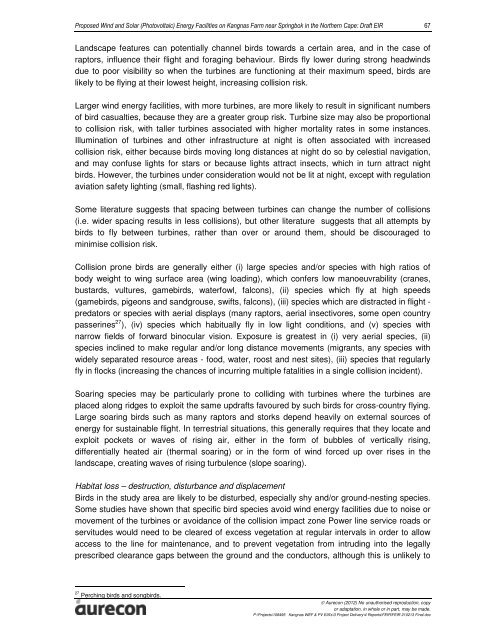
![CRR IV FEIR ~ 26042010 [FINAL].pdf - Environmental Projects](https://img.yumpu.com/21973020/1/184x260/crr-iv-feir-26042010-finalpdf-environmental-projects.jpg?quality=85)
